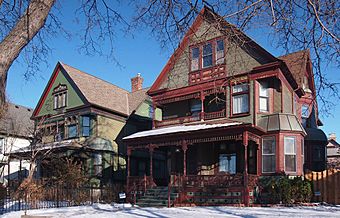Healy Block Residential Historic District facts for kids
Quick facts for kids |
|
|
Healy Block Residential Historic District
|
|

The Joseph B. Hudson and Healy-Rea Houses in the Healy Block Residential Historic District
|
|
| Location | 3101–3145 2nd Ave. S. and 3116–3124 3rd Ave. S., Minneapolis, Minnesota |
|---|---|
| Built | 1886–1898 |
| Architect | Theron Potter Healy |
| Architectural style | Queen Anne |
| NRHP reference No. | 93000417 |
| Added to NRHP | May 27, 1993 |
The Healy Block is a special neighborhood in Minneapolis, Minnesota. It has 14 beautiful houses built in the Queen Anne style. This area is so important that it's listed as a historic district. You can find it between Second Avenue South, 31st Street, Third Avenue South, and 32nd Street. These homes are a great example of Queen Anne style houses built by one person in Minneapolis.
Who Was Theron P. Healy?
Most of the homes in the Healy Block were built by a man named Theron P. Healy. He was a home builder in Minneapolis. Theron Healy moved to Minneapolis in 1884. He saw that areas in south Minneapolis were growing fast. Streetcars made it easy to get to these areas.
Healy decided to focus on building houses in the Queen Anne style. He worked on these homes between 1886 and 1898. He was a "Master Builder." This means he not only built the homes but also designed them himself. Besides the Healy Block, he built Queen Anne homes in other parts of Minneapolis too.
What is Queen Anne Style Architecture?
The Queen Anne style became popular in the United States after an event in Philadelphia in 1876. This style has some cool features. Houses often have roofs that face the front or have different angles. They use many different building materials. You might see balconies with fancy designs.
Other features include special window decorations. There are often stained glass windows above the main ones. These are called transoms.
Healy's Unique Touches
Theron Healy's designs included all the classic Queen Anne features. But he also added his own special touches. He often used brightly colored art glass in the transoms. He also put semicircular openings under the gables. Sometimes, the main entrance was not in the center of the house. Even though the houses share the Queen Anne style, each one in the Healy Block has its own unique details.



